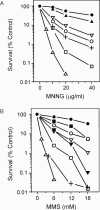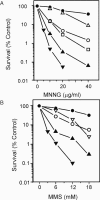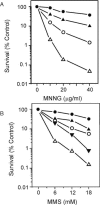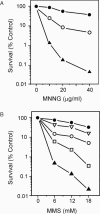Homologous recombination prevents methylation-induced toxicity in Escherichia coli
- PMID: 16670432
- PMCID: PMC1456334
- DOI: 10.1093/nar/gkl222
Homologous recombination prevents methylation-induced toxicity in Escherichia coli
Abstract
Methylating agents such as N-methyl-N'-nitro-N-nitrosoguanidine (MNNG) and methyl methane sulfonate (MMS) produce a wide variety of N- and O-methylated bases in DNA, some of which can block replication fork progression. Homologous recombination is a mechanism by which chromosome replication can proceed despite the presence of lesions. The two major recombination pathways, RecBCD and RecFOR, which repair double-strand breaks (DSBs) and single-strand gaps respectively, are needed to protect against toxicity with the RecBCD system being more important. We find that recombination-deficient cell lines, such as recBCD recF, and ruvC recG, are as sensitive to the cytotoxic effects of MMS and MNNG as the most base excision repair (BER)-deficient (alkA tag) isogenic mutant strain. Recombination and BER-deficient double mutants (alkA tag recBCD) were more sensitive to MNNG and MMS than the single mutants suggesting that homologous recombination and BER play essential independent roles. Cells deleted for the polA (DNA polymerase I) or priA (primosome) genes are as sensitive to MMS and MNNG as alkA tag bacteria. Our results suggest that the mechanism of cytotoxicity by alkylating agents includes the necessity for homologous recombination to repair DSBs and single-strand gaps produced by DNA replication at blocking lesions or single-strand nicks resulting from AP-endonuclease action.
Figures







Similar articles
-
Modulation of recombination and DNA repair by the RecG and PriA helicases of Escherichia coli K-12.J Bacteriol. 1996 Dec;178(23):6782-9. doi: 10.1128/jb.178.23.6782-6789.1996. J Bacteriol. 1996. PMID: 8955297 Free PMC article.
-
Homologous recombination protects mammalian cells from replication-associated DNA double-strand breaks arising in response to methyl methanesulfonate.DNA Repair (Amst). 2010 Oct 5;9(10):1050-63. doi: 10.1016/j.dnarep.2010.07.005. Epub 2010 Aug 13. DNA Repair (Amst). 2010. PMID: 20708982
-
Methyl methanesulfonate (MMS) produces heat-labile DNA damage but no detectable in vivo DNA double-strand breaks.Nucleic Acids Res. 2005 Jul 11;33(12):3799-811. doi: 10.1093/nar/gki681. Print 2005. Nucleic Acids Res. 2005. PMID: 16009812 Free PMC article.
-
Methylating agents and DNA repair responses: Methylated bases and sources of strand breaks.Chem Res Toxicol. 2006 Dec;19(12):1580-94. doi: 10.1021/tx060164e. Chem Res Toxicol. 2006. PMID: 17173371 Free PMC article. Review.
-
Mechanisms and consequences of methylating agent-induced SCEs and chromosomal aberrations: a long road traveled and still a far way to go.Cytogenet Genome Res. 2004;104(1-4):77-86. doi: 10.1159/000077469. Cytogenet Genome Res. 2004. PMID: 15162018 Review.
Cited by
-
A Gaussian process-based definition reveals new and bona fide genetic interactions compared to a multiplicative model in the Gram-negative Escherichia coli.Bioinformatics. 2020 Feb 1;36(3):880-889. doi: 10.1093/bioinformatics/btz673. Bioinformatics. 2020. PMID: 31504172 Free PMC article.
-
Arylphosphonium salts interact with DNA to modulate cytotoxicity.Mutat Res. 2009 Mar 17;673(2):141-8. doi: 10.1016/j.mrgentox.2009.01.002. Epub 2009 Jan 30. Mutat Res. 2009. PMID: 19429515 Free PMC article.
-
Characterization of the Neisseria meningitidis Helicase RecG.PLoS One. 2016 Oct 13;11(10):e0164588. doi: 10.1371/journal.pone.0164588. eCollection 2016. PLoS One. 2016. PMID: 27736945 Free PMC article.
-
Classical and novel properties of Holliday junction resolvase SynRuvC from Synechocystis sp. PCC6803.Front Microbiol. 2024 Apr 18;15:1362880. doi: 10.3389/fmicb.2024.1362880. eCollection 2024. Front Microbiol. 2024. PMID: 38699476 Free PMC article.
-
Interplay of DNA repair pathways controls methylation damage toxicity in Saccharomyces cerevisiae.Genetics. 2008 Aug;179(4):1835-44. doi: 10.1534/genetics.108.089979. Epub 2008 Jun 24. Genetics. 2008. PMID: 18579505 Free PMC article.
References
-
- Sedgwick B. Repairing DNA-methylation damage. Nat. Rev. Mol. Cell Biol. 2004;5:148–157. - PubMed
-
- Strauss B., Scudiero D., Henderson E. The nature of the alkylation lesion in mammalian cells. Basic Life Sci. 1975;5A:13–24. - PubMed
-
- Boiteux S., Laval J. Mutagenesis by alkylating agents: coding properties for DNA polymerase of poly (dC) template containing 3-methylcytosine. Biochimie. 1982;64:637–641. - PubMed
-
- Larson K., Sahm J., Shenkar R., Strauss B. Methylation-induced blocks to in vitro DNA replication. Mutat. Res. 1985;150:77–84. - PubMed

